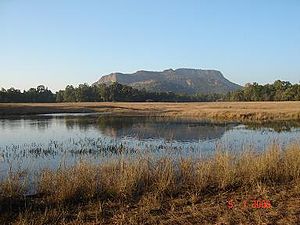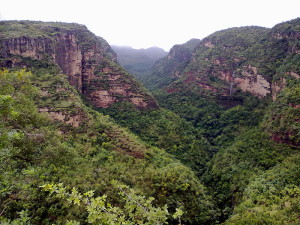Geography >> Regions | Climate | Flora & Fauna | Rivers | Languages
Topology, Regions & Location of Madhya Pradesh
Madhya Pradesh literally means “Central Province”, and is located in the geographic heart of India, between latitude 21°04’N-26.87°N and longitude 74°02′-82°49′ E. The state with an area of 3, 08, 000 sq.km. is the second largest state in India after Rajasthan. It is a part of peninsular plateau of India lying in north central part, whose boundary can be classified in the north by the plains of Ganga-Yamuna, in the west by the Aravali, east by the Chhattisgarh plain and in the south by the Tapti valley and the plateau of Maharashtra.The state straddles the Narmada River, which runs east and west between the Vindhya and Satpura ranges; these ranges and the Narmada are the traditional boundary between the north and south of India. The state is bordered on the west by Gujarat, on the northwest by Rajasthan, on the northeast by Uttar Pradesh, on the east by Chhattisgarh, and on the south by Maharashtra.
The state has been divided into following regions or zones depending upon the physical features:
- Kaimur Plateau and Satpura Hills
- Vindhyanchal Plateau (Hills)
- Narmada Sone valley
- Wainganga valley
- Gird (Gwalior) Region
- Bundelkhand Region
- Satpura Plateau (Hills)
- Malwa Plateau
- Nimar Plateau
- Jhabua Hills
Rivers in Madhya Pradesh
Based on the River basins, Madhya Pradesh has been divided into 5 river basins as below:
• Ganga /Yamuna Basin
• Narmada
• Tapti
• Mahi, and
• Wainganga (part of Godavari Basin)
Betwa, Sindh, Dhasan, Ken,Chambal, Paisuni and Baghian rivers join the Yamuna river and are the tributary sub-basins for Yamuna River Basin, which itself is a tributary to the Ganga Basin. Sone and Tapti rivers join the Ganga river directly and therefore, are the sub-basins to Ganga Basin.
Twelve rivers that originate in M.P. are Narmada(also known as Rewa), Mahi, Chambal, Betwa, Son, Tons, Tapti, ken, Dhasan, Kunwari, Sindh, Paisuni and Baghen. The total length of these rivers in M.P. is approximately 3956 kms and 553 kms share boundaries with other states. Narmada is the state river of the Madhya Pradesh and originates from Amarkantak valley.
Climate
Like most of north India,Madhya Pradesh has a subtropical climate. It has a hot dry summer (April–June), followed by monsoon rains (July–September) and a cool and relatively dry winter. The average rainfall is about 1,370 mm (53.9 in). It decreases from west to east because monsoon wind moves from west to east and drained clouds in western part takes less quantity of water vapours with them to eastern part. The south-western districts have the heaviest rainfall, some places receiving as much as 2,150 mm (84.6 in), while the western and north-western districts receive 1,000 mm (39.4 in) or less.
Ecology
 According to the 2011 census figures, the recorded forest area of the state is 94,689 km2 (36,560 sq mi) constituting 30.72% of the geographical area of the state. It constitutes 12.30% of the forest area of India. Legally this area has been classified into “Reserved Forest” (65.3%), “Protected Forest” (32.84%) and “Unclassified Forest” (0.18%). Per capita forest area is 2,400 m2 (0.59 acre) as against the national average of 700 m2 (0.17 acre). The forest cover is less dense in the northern and western parts of the state,
According to the 2011 census figures, the recorded forest area of the state is 94,689 km2 (36,560 sq mi) constituting 30.72% of the geographical area of the state. It constitutes 12.30% of the forest area of India. Legally this area has been classified into “Reserved Forest” (65.3%), “Protected Forest” (32.84%) and “Unclassified Forest” (0.18%). Per capita forest area is 2,400 m2 (0.59 acre) as against the national average of 700 m2 (0.17 acre). The forest cover is less dense in the northern and western parts of the state,  which contain the major urban centers. Variability in climatic brings about significant difference in the forest types of the state.
which contain the major urban centers. Variability in climatic brings about significant difference in the forest types of the state.
The major types of soils found in the state are:
- Black Soil, most predominantly in Malwa region
- Red and yellow soil, in Baghelkhand region
- Alluvial Soil, in Northern Madhya Pradesh
- Laterite Soil, in highland areas
- Mixed Soil, in parts of Gwalior and Chambal division
References
- http://en.wikipedia.org/wiki/Madhya_Pradesh

You must be logged in to post a comment.